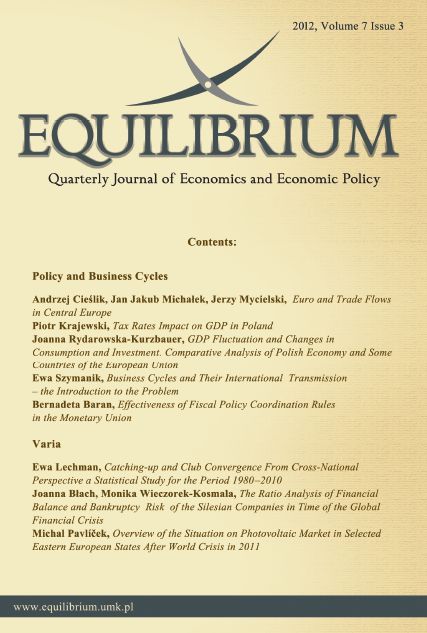Tax Rates Impact on GDP in Poland
DOI:
https://doi.org/10.12775/EQUIL.2012.017Keywords:
taxes, fiscal policyAbstract
In the article tax rates impact on GDP in Poland is analyzed. The analysis is based on dynamic stochastic general equilibrium model (DSGE model). Impulse-response analysis shows that the increase in income tax rate causes the decrease in capital, labour and production. Moreover, capital is partially replaced by consumption, because households minimize consumption fluctuations. The comparison of the effects of increasing taxation of the capital and labour shows that the impact on economy is stronger in case of wage taxes. Consumption taxes, by negative wealth effect, decrease after-tax consumption and capital, but on the other hand, increase labour and production. The direction of impact of consumption taxes on production is in this case opposite than in demand models.
Downloads
References
Barillas F., Colacito R., Kitao S., Matthes Ch., Sargent T. J., Shin Y. (2007), Practicing Dynare, http://www.dynare.org
Barro R. (1974), Are Government Bonds Net Wealth?, Journal of Political Economy, No. 82.
Brunila A., M. Buti, J. in 't Veld (2002), Fiscal policy in Europe: how effective are automatic stabilisers?, European Economy, Economic Papers No. 177.
Bukowski M., P. Kowal, P. Lewandowski, J. Zawistowski (2005), Struktura i poziom wydatków sektora finansów publicznych a sytuacja na rynku pracy. Doświadczenia międzynarodowe i wnioski dla Polski, The National Bank of Poland, The Departament of Social Communication, Warsaw.
Coricelli F., V. Ercolani (2002), Cyclical and Structural deficits on the Road to Accession: Fiscal Rules for an Enlarged European Union, Centre for Economic Policy Research, Discussion Paper Series No. 3672.
Grabek G., B. Kłos, G. Utzig-Lenarczyk (2007), SOE-PL ? model DSGE małej otwartej gospodarki estymowany na danych polskich, The National Bank of Poland, The Department of Social Communication, Warsaw .
Griffoli T. M. (2007), Dynare User Guide. An introduction to the solution and estimation of DSGE models, http://www.dynare.org.
Hansen G. D. (1985), Indivisible Labor and the Business Cycle, Journal of Monetary Economics, 16.
Jarociński M. (1997), Jednosektorowy model realnego cyklu koniunkturalnego na przykładzie Niemiec, Gospodarka Narodowa 9/97.
Józefiak, C., Krajewski, P., Mackiewicz M. (2005), Deficyt budżetowy. Przyczyny i metody ograniczenia, PWE, Warsaw 2006.
Kolasa M. (2008), Structural heterogeneity or asymmetric shocks? Poland and the euro area through the lens of a two-country DSGE model, The National Bank of Poland, The Department of Social Communication, Warsaw.
Kuchta Z. , K. Piłat (2010), Zastosowanie modelu realnego cyklu koniunkturalnego Hansena dla gospodarki Polski, Gospodarka Narodowa nr 11-12.
Kydland F. E., E. C. Prescott (1982), Time to Build and Aggregate Fluctuations, Econometrica Vol. 50, Issue 6.
Ljungqvist L., T. J. Sargent (2004), Recursive macroeconomic theory, MIT Press, Cambridge.
McGrattan (1994), The Macroeconomic Effects of Distortionary Taxation, Journal of Monetary Economics, 33.
Mc Morrow K., W. Roger (2001), Potential Output: Measurement Methods, ?New? Economy Influences and Scenarios for 2001-2010 ? A comparison of the EU15 and the US, European Communities, Economic Papers, No. 150.
Plosser Ch. I. (1989), Understanding Real Business Cycles, Journal of Economic Perspectives, nr 3.
Snowdon B., H. Vane, P. Wynarczyk (1998), Współczesne nurty teorii makroekonomii, State Scientific Publishers PWN, Warsaw.
Stadler G. W., (1994), Real Business Cycle, Journal of Economics Literature, nr 32, December.
Summers L.H. (1986), Some skeptical observations on real business cycle theory, Federal Reserve Bank of Minneapolis Quarterly Review, vol 10, nr 4.
Tobin J. (1978), Comment from Academic Scribbler, Journal of Monetary Economics, 4.






